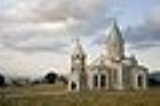
Ghazanchetsots Cathedral
Encyclopedia
Ghazanchetsots Cathedral , also known as the Cathedral of Christ the Holy Savior (Ղազանչեցոց Սուրբ Ամենափրկիչ Մայր Տաճար) and the Shushi Cathedral (Շուշիի Մայր Տաճար), is an Armenian church
located in Shusha
, Nagorno-Karabakh
.
when Shusha was under Azeri control.
The cathedral has seen a number of uses over the years. Its use as a functioning church ended after the Shusha pogrom
of 1920. During the Soviet period period it was used as a granary, and then as a garage. During the Nagorno-Karabakh War, Azerbaijani forces used the cathedral as a GRAD
munitions storehouse until May 1992, when Shusha was captured by Armenian forces. In the years after that capture the church was repaired and renovated. Replica angel statues were made to replace the destroyed originals; an image of one forms part of the coat-of-arms of Shusha. In 1998 it was re-consecrated as a church, and now serves as the main cathedral and headquarters of the Armenian Apostolic Church's Diocese of Artsakh.
Armenian architecture
Armenian architecture is an architectural style developed over the last 4,500 years of human habitation in the Armenian Highland and used principally by the Armenian people.- Common characteristics of Armenian architecture:...
located in Shusha
Shusha
Shusha , also known as Shushi is a town in the disputed region of Nagorno-Karabakh in the South Caucasus. It has been under the control of the self-proclaimed Nagorno-Karabakh Republic since its capture in 1992 during the Nagorno-Karabakh War...
, Nagorno-Karabakh
Nagorno-Karabakh
Nagorno-Karabakh is a landlocked region in the South Caucasus, lying between Lower Karabakh and Zangezur and covering the southeastern range of the Lesser Caucasus mountains...
.
History
Ghazanchetsots Cathedral was built between 1868 and 1887 and has a facade of white limestone. Its architect, Simon Ter-Hakobyan, intended the church to resemble Etchmiadzin Cathedral. In front of the west entrance is a freestanding three-story bell tower, constructed in 1858. Large statues of angels blowing trumpets stood at each corner of the bell tower's second story. However, they were destroyed during the Nagorno-Karabakh WarNagorno-Karabakh War
The Nagorno-Karabakh War was an armed conflict that took place from February 1988 to May 1994, in the small enclave of Nagorno-Karabakh in southwestern Azerbaijan, between the majority ethnic Armenians of Nagorno-Karabakh backed by the Republic of Armenia, and the Republic of Azerbaijan...
when Shusha was under Azeri control.
The cathedral has seen a number of uses over the years. Its use as a functioning church ended after the Shusha pogrom
Shusha pogrom
The Shusha pogrom of 1920 or the Massacre of Shusha"In March, 1920 a terrible pogrom took place in Shushi, organized by Azerbaijanis with the support of Turkish forces...
of 1920. During the Soviet period period it was used as a granary, and then as a garage. During the Nagorno-Karabakh War, Azerbaijani forces used the cathedral as a GRAD
BM-21
The BM-21 launch vehicle , a Soviet truck-mounted 122 mm multiple rocket launcher, and a M-21OF rocket were developed in the early 1960s. BM stands for boyevaya mashina, ‘combat vehicle’, and the nickname means ‘hail’. The complete system with the BM-21 launch vehicle and the M-21OF rocket...
munitions storehouse until May 1992, when Shusha was captured by Armenian forces. In the years after that capture the church was repaired and renovated. Replica angel statues were made to replace the destroyed originals; an image of one forms part of the coat-of-arms of Shusha. In 1998 it was re-consecrated as a church, and now serves as the main cathedral and headquarters of the Armenian Apostolic Church's Diocese of Artsakh.

